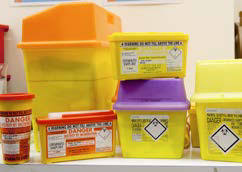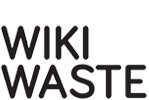Healthcare Waste: Difference between revisions
→Alternative Treatment: Additon of text |
|||
| Line 171: | Line 171: | ||
* [[Dry Heat]] | * [[Dry Heat]] | ||
Mechanical Treatment is also available as a pre-treatment option for any of the AT's outlined above. By pulverising, shredding, crushing etc the [[Healthcare Waste|waste]] this results in a reduction of the volume of the [[Healthcare Waste|waste]] by 60% plus although it does not kill any pathogens, | Mechanical Treatment is also available as a pre-treatment option for any of the AT's outlined above. By pulverising, shredding, crushing etc the [[Healthcare Waste|waste]] this results in a reduction of the volume of the [[Healthcare Waste|waste]] by 60% plus although it does not kill any pathogens, microorganisms or disinfect equipment<ref>[https://www.malsparo.com/treat2.htm/ Malsparo]</ref>. | ||
==References== | ==References== | ||
<references /> | <references /> | ||
Revision as of 15:46, 3 February 2021
Healthcare Waste is waste produced during human or animal healthcare, or related research activity, and covers both Clinical Waste and Offensive Waste as defined in the Controlled Waste (England and Wales) Regulations 2012 [1] and requires specific management measures. Healthcare Waste containing radioactive materials requirements compliance with specific guidance[2].

Clinical Waste
Clinical Waste is Healthcare Waste that:
- contains viable micro-organisms or their toxins which are known or reliably believed to cause disease in humans or other living organisms
- contains or is contaminated with a medicine that contains a biologically active pharmaceutical agent
- Medicine is a drug or other preparation for the treatment or prevention of disease
- Cytotoxic and cytostatic medicine is medicine that possesses hazardous properties which are toxic, carcinogenic, mutagenic or toxic for reproduction.
- is a sharp, or a body fluid, or other biological material (including human and animal tissue), containing or contaminated with a hazardous substance
- A sharp is an item that could cause cuts or puncture wounds. This includes needles, hypodermic needles, scalpels and other blades, knives, infusion sets, saws, broken glass, and nails.
- is waste of a similar nature from a non-healthcare activity
Offensive Waste
Offensive Waste is non-infectious waste which is unpleasant and may cause offence to those coming into contact with it. It includes[3]:
- outer dressings and protective clothing e.g. masks, gowns and gloves that are not contaminated with body fluids
- hygiene waste and sanitary protection e.g. nappies and incontinence pads
- autoclaved laboratory waste.
- falls within EWC waste codes 18 01 04, 18 02 03 or 20 01 99.
Offensive waste does not include [3]:
- sharps
- anatomical waste e.g.body parts, organs or blood
- chemicals, medicines
- dental amalgam
- any waste that is infectious (i.e. a clinical waste)
Management of Healthcare Waste
The management of Healthcare Wastes is set out in Healthcare Technical Memorandum 07-01 - Safe Management of Healthcare Waste[4] which replaced the Safe Management of Healthcare Waste in 2013 [5]. Management of Healthcare Waste for regulated facilities with an environmental permit is the subject of guidance issued in July 2020 [6] by the EA which sets out appropriate measures in the following sections:
- When appropriate measures apply
- Definition of Healthcare Waste (as set out in the table below)
- Managing healthcare wastes
- General management appropriate measures
- Waste pre-acceptance, acceptance and tracking appropriate measures
- Waste storage, segregation and handling appropriate measures
- Waste treatment appropriate measures (including assessment and validation requirements)
- Emissions control appropriate measures
- Emissions monitoring and limits appropriate measures
- Process efficiency appropriate measures
Healthcare Waste - Packaging Colour and Appropriate Waste Management
The types of Healthcare Waste are grouped and designated by packaging colour set out in the table below (can be bag colour or lid colour)[7] Cite error: The opening <ref> tag is malformed or has a bad name:
| Colour of Packaging: Orange | ||||||
|---|---|---|---|---|---|---|
| Appropriate healthcare waste management activities | Storage, alternative treatment or Incineration | |||||
| Waste types and List of Waste (LoW) code(s) | Infectious waste, not contaminated with chemicals or medicines | |||||
| human healthcare (may contain sharps) - 18 01 03* | ||||||
| animal healthcare (may contain sharps) - 18 02 02* | ||||||
| municipal, separately collected fractions, not from healthcare or research-related sources (may contain sharps) - 20 01 99 | ||||||
| commercial, separately collected fractions of absorbents, wiping cloths and protective clothing contaminated by infectious substances - 15 02 02 | ||||||
| Colour of Packaging: Yellow | ||||||
| Appropriate healthcare waste management activities | Storage and Incineration | |||||
| Waste types and List of Waste (LoW) code(s) | Infectious waste, contaminated with chemicals: | |||||
| human healthcare - 18 01 03* and 18 01 06* or 18 01 07 | ||||||
| animal healthcare - 18 02 02* and 18 02 05* or 18 02 06 | ||||||
| Infectious waste, medicinally contaminated (not cytotoxic or cytostatic): | ||||||
| human healthcare (may contain sharps) - 18 01 03* and 18 01 09 | ||||||
| animal healthcare (may contain sharps) - 18 02 02* and 18 02 08 | ||||||
| Colour of Packaging: Red | ||||||
| Appropriate healthcare waste management activities | Storage and Incineration | |||||
| Waste types and List of Waste (LoW) code(s) | Infectious anatomical waste, chemically preserved: | |||||
| Human healthcare – 18 01 03* and 18 01 06* or 18 01 07 | ||||||
| Animal healthcare – 18 02 02* and 18 02 05* or 18 02 06 | ||||||
| Infectious anatomical waste, not chemically preserved: | ||||||
| Human healthcare – 18 01 03* | ||||||
| Animal healthcare – 18 02 02* | ||||||
| Non-infectious anatomical waste, chemically preserved: | ||||||
| Human healthcare - 18 01 02 and 18 01 06* or 18 01 07 | ||||||
| Animal healthcare - 18 02 03 and 18 02 05* or 18 02 06 | ||||||
| Non-infectious anatomical waste, not chemically preserved: | ||||||
| Human healthcare - 18 01 02 | ||||||
| Animal healthcare - 18 02 03 | ||||||
| Colour of Packaging: Purple | ||||||
| Appropriate healthcare waste management activities | Storage and Incineration | |||||
| Waste types and List of Waste (LoW) code(s) | Cytotoxic and cytostatic medicines: | |||||
| Human healthcare – 18 01 08* | ||||||
| Animal healthcare – 18 02 07* | ||||||
| Infectious waste, contaminated with cytotoxic and cytostatic medicines: | ||||||
| Human healthcare (may contain sharps) - 18 01 03* and 18 01 08* or 20 01 31* | ||||||
| Animal healthcare (may contain sharps) - 18 02 02* and 18 02 07* or 20 01 31* | ||||||
| Colour of Packaging: Blue | ||||||
| Appropriate healthcare waste management activities | Storage and Incineration | |||||
| Waste types and List of Waste (LoW) code(s) | Other waste medicines, excluding cytotoxic and cytostatic medicines | 18 01 09, 18 02 08 or 20 01 32 | ||||
| Colour of Packaging: Black and Yellow ('tiger bags') | ||||||
| Appropriate healthcare waste management activities | Storage, Incineration or Landfill. Compaction, where specifically permitted. | |||||
| Waste types and List of Waste (LoW) code(s) | Non-infectious offensive waste: | |||||
| Human healthcare – 18 01 04 | ||||||
| Animal healthcare – 18 02 03 | ||||||
| Municipal, separately collected fractions of absorbents, wiping cloths and protective clothing | 15 02 03 not contaminated by infectious substances | |||||
| Colour of Packaging: Not Specified | ||||||
| Appropriate healthcare waste management activities | Storage, Incineration or Landfill. Compaction, where specifically permitted. | |||||
| Waste types and List of Waste (LoW) code(s) | Non-infectious offensive waste: | |||||
| Human healthcare – 18 01 04 | ||||||
| Animal healthcare – 18 02 03 | ||||||
| Municipal, separately collected fractions of absorbents, wiping cloths and protective clothing | 15 02 03 not contaminated by infectious substances | |||||
Treatment and Disposal of Healthcare Waste
With regard to the table above, it can be seen that there are options for incineration and alternative treatment and in some specific cases landfill is acceptable.
Incineration
For incineration, Healthcare Waste will normally be incinerated in a High Temperature Incinerator or dedicated Clinical Waste Incinerator. Some Residual Waste EFW incinerators are able to dispose of specific Clinical Waste streams, and as a result of the COVID-19 pandemic the EA has published a Regulatory Position Statement (RPS C23) clarifying the circumstances where COVID-19 waste can be incinerated with Municipal Waste Waste (MSW) until July 2021. [8]
Alternative Treatment
There are several types of Alternative Treatments (AT) available for the treatment of Healthcare Waste all of which must demonstrate that the Healthcare Waste is 'rendered safe'Cite error: The opening <ref> tag is malformed or has a bad name. 'Rendered safe' means:
- demonstrates the ability to reduce the number of infectious organisms present in the waste to a level at which no additional precautions are needed to protect workers or the public against infection from the waste;
- destroys anatomical waste such that it is no longer generally recognisable;
- renders all Clinical Waste (including any equipment and sharps) unusable and unrecognisable as Clinical Waste;
- destroys the component chemicals of chemical or medicinal and medicinally-contaminated waste.
such treatments include:
Mechanical Treatment is also available as a pre-treatment option for any of the AT's outlined above. By pulverising, shredding, crushing etc the waste this results in a reduction of the volume of the waste by 60% plus although it does not kill any pathogens, microorganisms or disinfect equipment[9].
References
- ↑ Definition of Healthcare Waste
- ↑ The Radioactive Substances Regulation Guidance
- ↑ 3.0 3.1 NetRegs
- ↑ Link to pdf document
- ↑ Published in 2006, this removed the clinical waste classification system categorising into 5 types; A to E
- ↑ Healthcare Waste:Appropriate Measures for Permitted Facilities
- ↑ Types of Healthcare Waste
- ↑ RPS C23
- ↑ Malsparo
